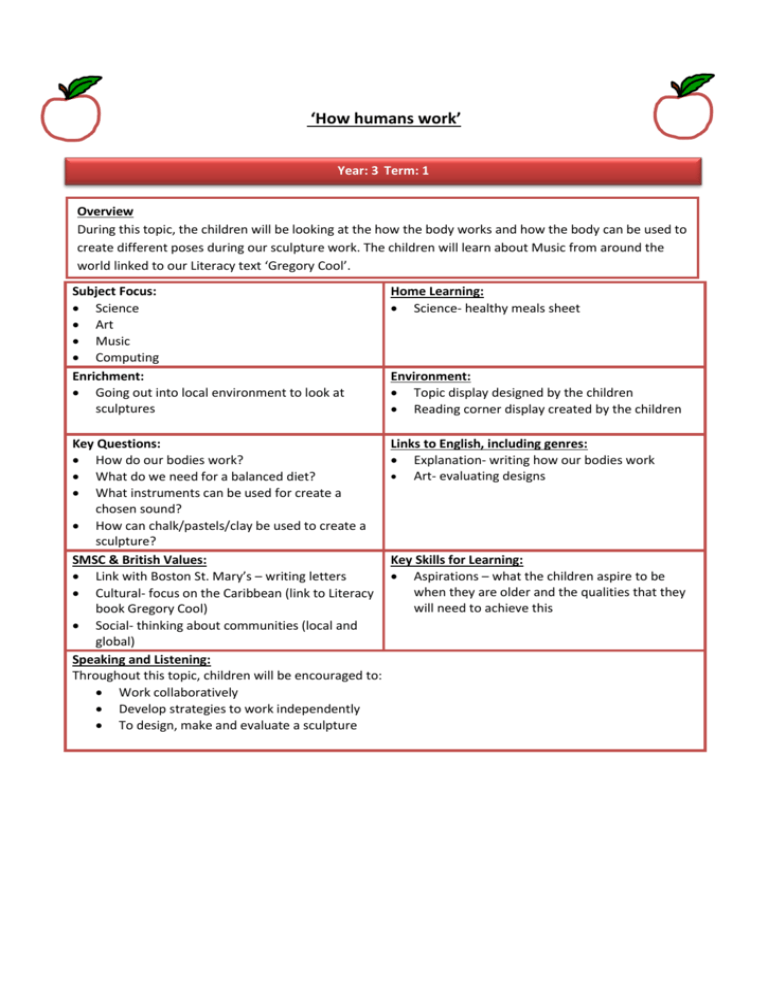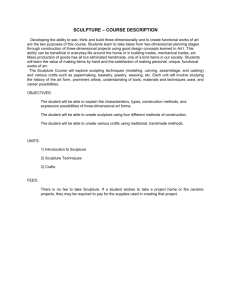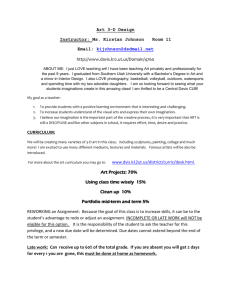How humans work Term 1
advertisement

‘How humans work’ Year: 3 Term: 1 Overview During this topic, the children will be looking at the how the body works and how the body can be used to create different poses during our sculpture work. The children will learn about Music from around the world linked to our Literacy text ‘Gregory Cool’. . Subject Focus: Science Art Music Computing Enrichment: Going out into local environment to look at sculptures Home Learning: Science- healthy meals sheet Key Questions: How do our bodies work? What do we need for a balanced diet? What instruments can be used for create a chosen sound? How can chalk/pastels/clay be used to create a sculpture? SMSC & British Values: Link with Boston St. Mary’s – writing letters Cultural- focus on the Caribbean (link to Literacy book Gregory Cool) Social- thinking about communities (local and global) Speaking and Listening: Throughout this topic, children will be encouraged to: Work collaboratively Develop strategies to work independently To design, make and evaluate a sculpture Links to English, including genres: Explanation- writing how our bodies work Art- evaluating designs Environment: Topic display designed by the children Reading corner display created by the children Key Skills for Learning: Aspirations – what the children aspire to be when they are older and the qualities that they will need to achieve this Programmes of Study English: Science Writing Human skeleton and nutrition: To discuss and record ideas Identify that animals, including humans, need the right types and amount of nutrition, and that To organise paragraphs around a theme they cannot make their own food; they get To assess the effectiveness of their own and nutrition from what they eat others’ writing and suggest improvements Identify that humans and some other animals To create settings, characters and plot have skeletons and muscles for support, Handwriting- use the diagonal and horizontal protection and movement strokes that are needed to join letters and understand which letters, when adjacent to one another, are best left unjoined Grammar To choose nouns or pronouns appropriately for clarity and cohesion and to avoid repetition To use fronted adverbials To indicate possession by using the possessive apostrophe with plural nouns To use and punctuate direct speech Reading To listen and discuss a wide range of fiction, poetry, plays, non-fiction and reference books or textbooks To read books that are structured in different ways and reading for a range of purposes To use dictionaries to check the meaning of words that they have read Maths: Number and place value: Identify, represent and estimate numbers in different ways Recognise place value of each digit in a 3 digit number Compare + order numbers to 1000 Read and write numbers to 1000 in numerals and words Find 10 or 100 more or less with different 2 and 3 digit numbers + - up to 3 digits using a written method Art: Sculpture: Create sketch books to record observations and use them to review and revisit ideas Henry Moore- finding out who he was, looking at examples of his work and recreating his work using our bodies Improve Art and design techniques (sculpture) using different materials Computing: Select and use digital devices to present information (word processing) Use technology safely, respectfully and responsibly Music Play and perform in solo and ensemble contexts, using voices and playing musical instruments with increasing accuracy, fluency, control and expression Improvise and compose music for a range of purposes Appreciate and understand a wide range of high-quality live and recorded music drawn from different traditions and from great composers and musicians Develop an understanding of the history of music How you can help at home: Practise mental maths methods learnt in class (1 minute tests) Practise times tables Practise spellings Complete reading diary entries









